From dew to streams, learn how to find and purify water in any environment. Be prepared, be safe, be smart.
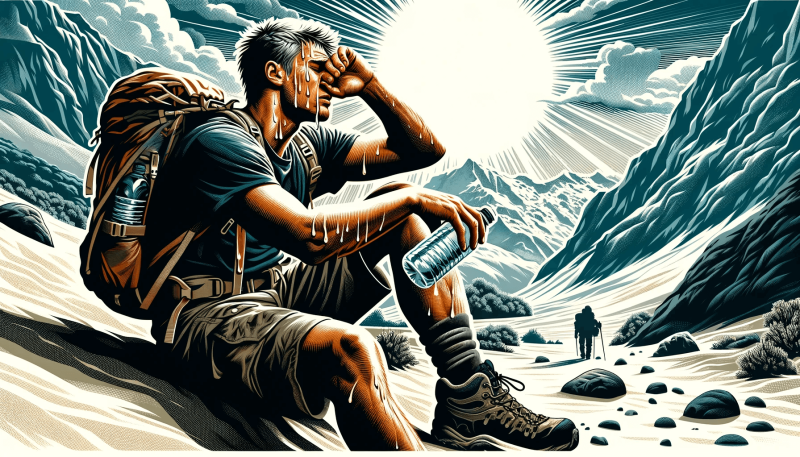
Section 1: Understanding the Importance of Water in the Wilderness
As a hiker or backpacker, it’s crucial to understand the significance of water while you’re out in the wild. Let’s dive into why water is your number one priority.
The Role of Hydration in Maintaining Health and Endurance
Water is life. It’s not just a phrase; it’s a literal truth, especially in the wilderness. Your body relies on water for every function — from regulating your temperature to maintaining your energy levels. When you’re hiking or backpacking, you’re exerting a lot of energy. This means your body needs more water to keep up. Staying hydrated helps you maintain your stamina, so you can enjoy your adventure to the fullest.
Risks Associated with Dehydration
Dehydration is a silent threat. It can creep up on you, and before you know it, you’re feeling the effects. These include dizziness, fatigue, and confusion. In severe cases, it can lead to heat stroke or hypothermia, depending on the weather conditions. Remember, by the time you feel thirsty, you’re already dehydrated. It’s a mistake you don’t want to make.
Dangers of Waterborne Illnesses
Nature’s water sources can be deceptive. They may look clean, but they can harbor pathogens like bacteria, viruses, and parasites. Drinking contaminated water can lead to serious illnesses, like giardia or cryptosporidium. These illnesses can incapacitate you, turning a wilderness adventure into a survival situation.
In conclusion, understanding the importance of water in the wilderness is not just about quenching your thirst. It’s about keeping you healthy, energized, and safe. Hydration is not something to take lightly — it’s essential for your survival and enjoyment out in the wild. Stay informed, stay prepared, and most importantly, stay hydrated.
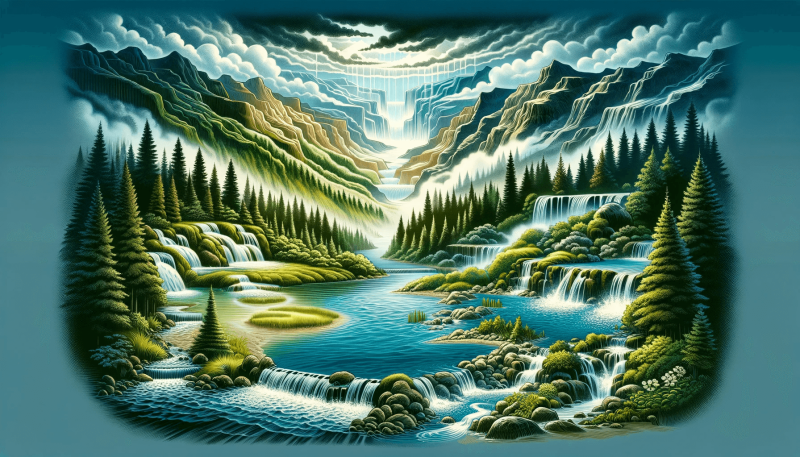
Section 2: Identifying Safe Water Sources
When you’re out in the wild, finding a safe source of water is as crucial as knowing how to purify it. Let’s explore how to identify where you can safely quench your thirst.
Natural Water Sources: Rivers, Streams, Lakes, and Springs
The wilderness is full of natural water sources, but not all are safe. Rivers and streams are often your best bet, as moving water is less likely to harbor harmful bacteria compared to stagnant water. Springs are usually a good choice too, as they often provide fresh, filtered water. Lakes can be safe, but they require more caution due to potential contaminants. Always look for clear, flowing water — it’s your safest option.
Indicators of Potentially Unsafe Water
Beware of still water. Stagnant pools are breeding grounds for pathogens. Be cautious of water sources near animal tracks or droppings, as these can be contaminated. Also, avoid water downstream from industrial areas, mining sites, or heavy agricultural zones. These areas can introduce harmful chemicals into the water. Trust your instincts. If it doesn’t look or smell right, it’s best to avoid it.
Seasonal and Environmental Factors Affecting Water Safety
Seasons change, and so does water safety. In spring, melting snow can swell rivers and increase the risk of contamination from runoff. In summer, lower water levels can lead to higher concentrations of pathogens in stagnant pools. Be aware of recent weather events too. Heavy rains can wash contaminants into water sources, while droughts can reduce the flow, increasing stagnation. Always adapt to the environment.
In conclusion, finding safe water in the wild is about understanding your surroundings and recognizing the signs of potential danger. Natural water sources can be lifesavers, but they can also pose risks. Be observant, be cautious, and remember: if in doubt, it’s better to seek another source or purify the water you have. Your health and safety depend on it.
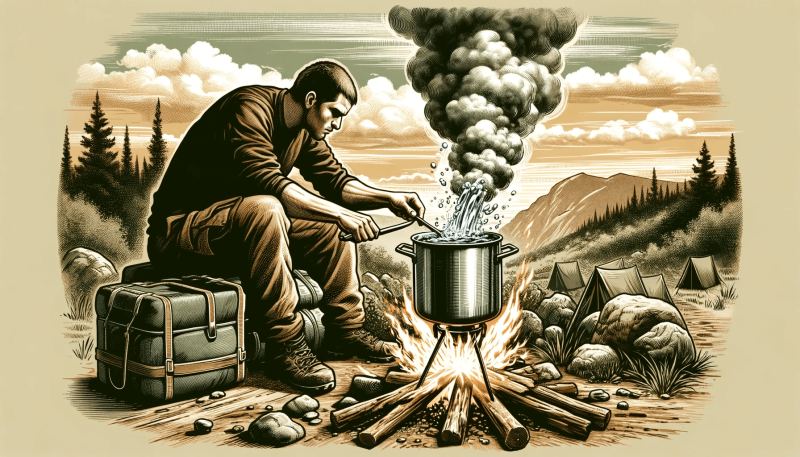
Section 3: Methods of Water Purification
In the wilderness, knowing how to purify water is as essential as finding it. Let’s look at the methods you can use to ensure the water you drink is safe.
Boiling: Process and Effectiveness
Boiling is the most reliable method to purify water. It’s simple. Bring the water to a rolling boil for at least one minute. At higher altitudes, boil it for three minutes. Boiling kills bacteria, viruses, and parasites. It’s your go-to method when you have a heat source. Remember, when it comes to boiling, patience is key.
Chemical Treatment: Types and Usage Guidelines
Chemical purifiers, like iodine or chlorine tablets, are effective and lightweight options. However, they take time — usually 30 minutes to an hour. Follow the instructions carefully. The water should be clear; if it’s cloudy, filter it first. Chemical treatments have a taste, but it’s a small price for safe water. Always check the expiration date.
Filtration Systems: Different Types and Their Suitability for Backpacking
Water filters are convenient and effective. There are many types, from pump filters to squeeze filters and straw-style filters. Choose one based on your needs and the size of your pack. Filters remove bacteria and protozoa, but most can’t filter out viruses. If viruses are a concern, combine filtering with boiling or chemical treatments.
UV Light Purification: Usage and Limitations
UV purifiers use ultraviolet light to kill pathogens. They’re fast and effective, but they require batteries and clear water. If the water is cloudy, pre-filter it. UV light doesn’t leave a taste, but it’s technology-dependent. Always have a backup, like boiling or chemical treatments.
In conclusion, each water purification method has its pros and cons. Your choice depends on your situation, the environment, and your gear. Sometimes, you’ll need to combine methods for maximum safety. Remember, safe drinking water is non-negotiable. It’s the difference between a memorable adventure and a survival challenge. Stay safe, stay hydrated.
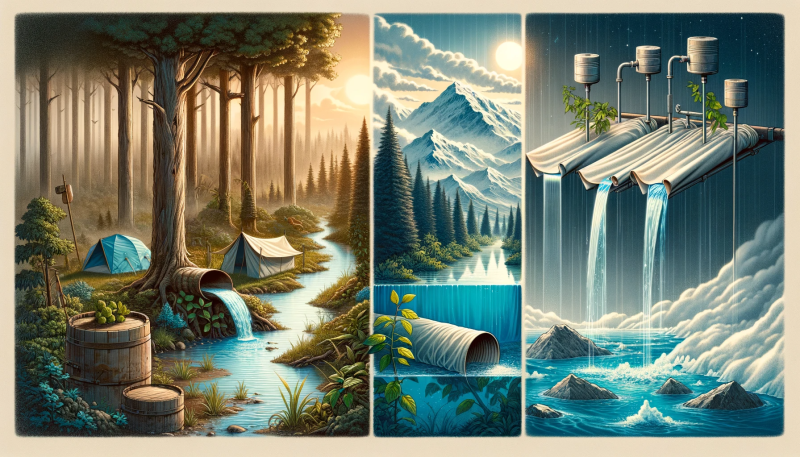
Section 4: Practical Skills for Water Sourcing
Finding and collecting water in the wilderness requires more than just intuition. It’s about knowing where and how to look. Let’s delve into the practical skills you’ll need.
Techniques for Collecting Water in Different Environments
Each environment offers unique challenges and opportunities for water sourcing. In forests, look for streams or collect rainwater. In arid areas, morning dew on plants can be a valuable water source. In mountainous regions, melting snow is an option, but remember to purify it. Use cloth to absorb dew or funnel rainwater into containers. Always think creatively and use what the environment provides.
Efficient Water Storage and Conservation Strategies
Storing water efficiently is crucial. Use collapsible containers to save space. Keep water cool and out of direct sunlight to prevent bacterial growth. Conserve water by rationing and using it wisely. Don’t waste it. Remember, the water you have is the water you need to survive. Be mindful of every drop.
Signs of Water Sources When None Are Immediately Visible
Learning to read nature’s signs can lead you to water. Vegetation is greener near water sources. Bird flights often indicate the direction of water. Insects, especially mosquitoes, tend to be more prevalent near water. Animal tracks can lead to water sources too. Pay attention to the landscape. Nature will guide you.
In conclusion, sourcing water in the wild is an art and a science. It requires knowledge, observation, and a bit of ingenuity. Be aware of your surroundings, conserve what you have, and always be on the lookout for signs of water. Remember, your survival may depend on it. Stay alert, stay resourceful.
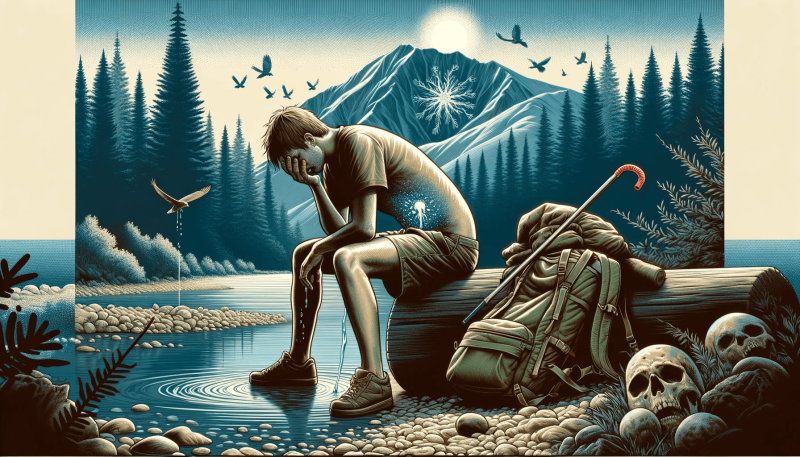
Section 5: Health and Safety Precautions
In the wilderness, taking care of your health and safety, especially when it comes to water, is non-negotiable. Let’s focus on how to stay safe while staying hydrated.
Recognizing Signs of Waterborne Illnesses
Waterborne illnesses can be subtle at first. Look out for symptoms like nausea, diarrhea, stomach cramps, and fever. These signs can appear a few days after drinking contaminated water. Be vigilant. Your health is your most valuable asset in the wild.
First-Aid Measures for Water-Related Health Issues
If you suspect a waterborne illness, act fast. Increase your fluid intake with purified water to prevent dehydration. If you have them, use oral rehydration salts. Rest is crucial. If symptoms persist, seek medical attention as soon as possible. Remember, prompt action can make all the difference.
Pre-Trip Preparation and Emergency Planning
Preparation is key. Before your trip, learn about the potential waterborne hazards in the area. Pack a well-stocked first-aid kit, including water purification tools and rehydration salts. Familiarize yourself with basic first-aid procedures. Plan your route and let someone know your itinerary. Always have an emergency plan. It’s better to be over-prepared than under-prepared.
In conclusion, when it comes to your health and safety in the wilderness, being proactive is vital. Recognize the signs of trouble, know how to respond, and always prepare thoroughly before setting out. Your well-being depends on the precautions you take and your ability to respond to challenges. Stay safe, stay smart.
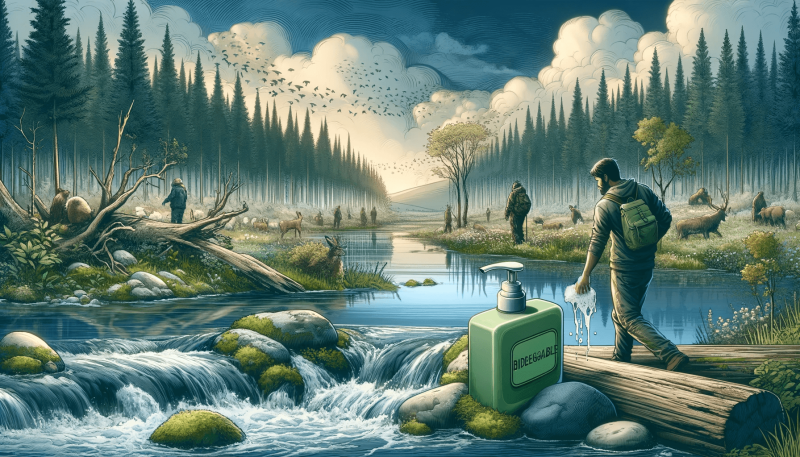
Section 6: Environmental Considerations and Responsibilities
When sourcing water in the wilderness, it’s not just about your survival. It’s also about respecting and preserving the natural environment. Let’s explore how you can do both.
Impact of Human Activity on Natural Water Sources
Our actions have consequences. Remember, the water sources you use are part of a larger ecosystem. Contamination from human activities can harm wildlife and the environment. Use biodegradable soap sparingly. Never wash directly in streams or lakes. Be mindful. Your choices affect the health of the ecosystem.
Leave-No-Trace Principles Related to Water Sourcing
Adhering to Leave-No-Trace principles is essential. When collecting water, disturb the area as little as possible. Avoid trampling vegetation or disrupting habitats. If you create a path to a water source, make it as unobtrusive as possible. Your goal is to leave the area as you found it, or even better. Preservation is key.
Responsible Water Usage in Wilderness Settings
Use water responsibly. Avoid wasting it. This means taking only what you need and using it efficiently. If you’re camping near a water source, set up camp at least 200 feet away to prevent contamination. Share your knowledge with fellow hikers and backpackers. Together, we can protect our precious water resources.
In conclusion, sourcing water in the wilderness is a privilege that comes with responsibility. Your actions impact the environment and its inhabitants. By being mindful and practicing responsible water usage, you contribute to the preservation of these vital natural resources. Respect nature. It’s our collective duty.
FAQ: Surviving in the Wild – Water Purification and Sourcing
How do I find water in the wilderness?
Look for natural signs like lush vegetation, insect activity, and animal tracks, which can lead to water sources. Rivers, streams, and springs are typically reliable sources.
Is it safe to drink directly from a natural water source?
No, it’s not safe. Natural water can contain pathogens. Always purify water from rivers, lakes, or streams before drinking.
What are the best methods to purify water in the wild?
Boiling is the most reliable method. Other effective methods include using chemical treatments, filtration systems, and UV light purifiers.
How long should I boil water to make it safe to drink?
Boil water for at least one minute at lower altitudes and three minutes at altitudes above 6,500 feet.
Can I drink melted snow?
Yes, but you should purify it first. Melted snow can contain bacteria and other contaminants.
What are the symptoms of waterborne illnesses?
Common symptoms include nausea, diarrhea, stomach cramps, and fever. These can occur a few days after consuming contaminated water.
How much water should I drink while hiking?
Aim to drink about half a liter (17 ounces) per hour during moderate activity in moderate temperatures. Adjust based on your activity level, the climate, and your personal needs.
How can I conserve water while hiking?
Carry an appropriate amount, use it sparingly, and prioritize it for hydration over other uses. Store it properly to prevent contamination and wastage.
What should I do if I can’t find a water source?
Use your map and compass to locate nearby rivers or lakes. If you’re lost, follow animal tracks or valleys as they often lead to water.
How can I ensure I leave no trace when sourcing water?
Collect water with minimal disturbance to the surroundings, use biodegradable soaps away from water sources, and camp at least 200 feet from any water source to prevent contamination.
These questions cover the essentials of finding, purifying, and conserving water in the wilderness, helping you stay hydrated and safe during your outdoor adventures.
Sure, I’ll create a two-column table relevant to the topic of surviving in the wild, specifically focusing on water purification and sourcing. The table will contrast two different aspects related to this topic.
| Water Sourcing Techniques | Water Purification Methods |
|---|---|
| 1. Identifying Water Sources: Look for rivers, streams, lakes, and morning dew. Pay attention to animal behavior and vegetation, indicating water nearby. | 1. Boiling: Boiling water for at least one minute at lower altitudes, and three minutes at higher altitudes to kill pathogens. |
| 2. Collecting Water: Use containers, cloths, or natural elements to collect rainwater, dew, or water from streams and lakes. | 2. Chemical Treatment: Using iodine or chlorine tablets to purify water, especially useful when boiling is not possible. |
| 3. Using Natural Indicators: Green vegetation, insect presence, and animal tracks can lead to water sources. | 3. Filtration Systems: Using portable filters like pump, squeeze, or straw filters to remove bacteria and protozoa. |
| 4. Conserving Water: Rationing water usage, avoiding contamination, and storing water properly to prolong its usability. | 4. UV Light Purification: Using UV purifiers for quick and effective water treatment, suitable for clear water. |
| 5. Seasonal Considerations: Understanding how different seasons affect water availability and quality, like snowmelt in spring or dry water beds in summer. | 5. Pre-Filtering: When using chemical or UV treatments, pre-filtering to remove sediments and debris from cloudy water. |
| 6. Environmental Impact: Minimizing disruption to natural water sources and following Leave-No-Trace principles. | 6. Backup Methods: Always having a secondary method for purification in case the primary method fails or is unsuitable. |
This table provides a comprehensive overview of the essential techniques for sourcing and purifying water in the wild, highlighting the importance of each step in ensuring safe and sustainable water use during outdoor activities.
Sure, I can help you with that. Here are some articles that you might find helpful:
Related Articles From Around The Internet
1. What Do You Need To Survive In The Wild? ( Top 29 Items )
This article from Prepping Planet provides a comprehensive list of the top 29 items you need to survive in the wild. It covers everything from food and water to shelter and protection from the elements.
2. Best Outdoor Survival Equipment: 10 Things You Need To Survive In The Wild
This article from Survival Axis lists the top 10 things you need to survive in the wilderness. It covers the four essential needs for survival in the wild: shelter, warmth, water, and food.
3. Survival Skills: 7 Wilderness Survival Skills to Learn
This article from MasterClass provides an overview of seven essential wilderness survival skills. It covers topics such as building a shelter, finding water, and starting a fire.
4. How To Survive in the Wild: The Only 4 Things You Need!
This article from Primal Survivor explains that there are only four things you need to survive in the wild: water, shelter, food, and warmth. It provides tips on how to obtain each of these necessities.
I hope you find these articles helpful!
Ever wondered how expert survivalists make it in the wild? Discover their secrets with Covert Survivor. Subscribe to our blog and unlock the mysteries of wilderness survival.








